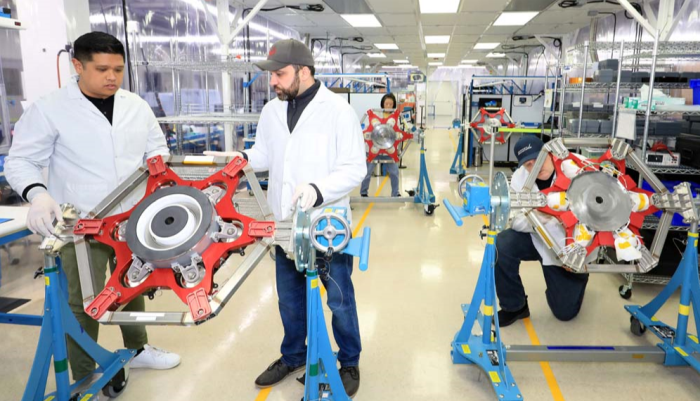
May 19, 2023 - Aerojet Rocketdyne and NASA are on track to fly the highest power, highest thrust continuously operated electric propulsion (EP) system ever flown with the recent delivery of a qualification unit to NASA’s Glenn Research Center.
A 12-kilowatt (kW) Advanced Electric Propulsion System (AEPS) qualification thruster, built by Aerojet Rocketdyne, was recently delivered to NASA’s Glenn Research Center in Cleveland for testing to certify the thruster technology for future NASA missions. Once the AEPS thruster is certified, it has potential uses on a wide range of human and robotic missions for government and commercial space customers.
The first set of AEPS thrusters are slated to fly and be the primary source of propulsion on the Power and Propulsion Element (PPE) of Gateway, the lunar space station that will support the NASA-led Artemis missions to return humans to the Moon and chart a path for human missions to Mars.
“Aerojet Rocketdyne helped pioneer the use of electric propulsion to maneuver spacecraft in orbit and has delivered more than 600 electric propulsion thrusters that have been used on more than 250 satellites to date,” said Jack Fisher, manager of advanced in-space programs at Aerojet Rocketdyne. “AEPS is the next evolution of this system, and demonstrating it on Gateway will give our commercial, civil and defense customers confidence that AEPS is the right solution for their platforms.”
Three AEPS thrusters will propel PPE on its journey from Earth to the Moon, providing 36 kWs of the total 48 kWs of spacecraft electric propulsion, making it the most powerful solar electric propulsion system ever flown. The thrusters will provide orbit-raising maneuvers to the Moon and will then perform stationkeeping to maintain the Gateway in orbit for a minimum of 15 years.
Aerojet Rocketdyne’s state-of-the-art, magnetically-shielded AEPS thruster represents the next-generation of high-power EP systems capable of supporting human missions to the Moon and Mars.
“High-power electric propulsion is critical to achieving the agency’s deep space exploration and science objectives, and Advanced Electric Propulsion System qualification is the first step toward bringing those future opportunities within reach,” said Trudy Kortes, director of technology demonstrations in NASA’s Space Technology Mission Directorate. “Supporting the demonstration of technologies like this is key to providing increased capabilities and flexibility for some of our most ambitious missions.”
Following final assembly of the first qualification model thruster in March, acceptance level vibration testing was successfully performed at Aerojet Rocketdyne’s Redmond, Washington facility. Acceptance level hot-fire characterization testing is planned at NASA Glenn’s Electric Power and Propulsion Laboratory in May and June, to be followed by qualification level shock, vibration, and thermal characterization testing to demonstrate the system’s capability over all flight conditions and environments.
The qualification test campaign will conclude by demonstrating long-duration performance of the thruster by running a second qualification thruster for more than 23,000 hours – equal to about 2.5 years of continuous operation and demonstrating the total throughput and operational cycles required during the planned minimum 15-year Gateway mission.
Aerojet Rocketdyne is simultaneously building the three flight thrusters while qualification testing is completed. The flight thrusters will be acceptance tested at NASA Glenn before delivery to Maxar Technologies for integration with PPE in 2024.

